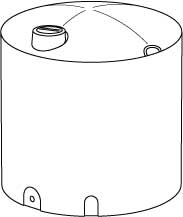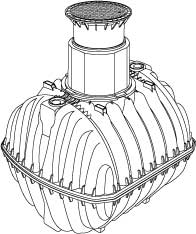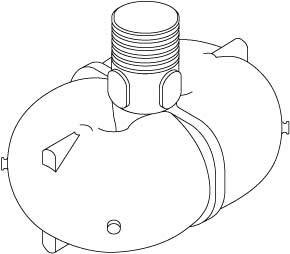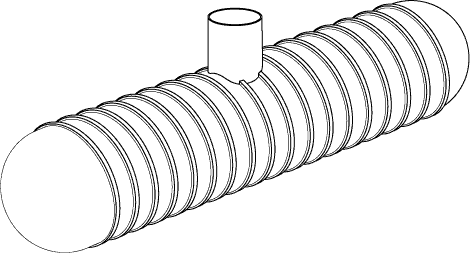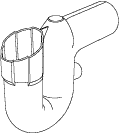 General Information
General InformationGreen Roofs
Rainwater Harvesting
Systems
Pre-Filtration
Storage
RainBox
RainColumn
SuperBarrel
RainSilo
Hercules
Carat
DoubleTorus
RainSub
RainCavern
Pumping
Treatment
Measurement + Control
Backup Integration
Design
Documents
Ponds and Wetlands
Energy-Efficient Building
Waterproofing

RAINWATER STORAGE
Storage is usually the most expensive component of a rainwater system and often determines the type of filtration and pumping system. We provide a wide range of storage solutions from a 75 gallon consumer tank to custom-designed modular systems capable of storing millions of gallons to run large commercial or multi-family structures or irrigation systems.
SURFACE STORAGE: Free-standing plastic tanks provide the least expensive means of rainwater storage, both in purchase cost and installation cost. They are relatively easy to handle, require little or no excavation, and work with almost any topography. On the other hand, they have many liabilities;
• Plumbing and pre-filtration can be problematic when surface tanks are used for large roofs with multiple downspouts.
• Without expensive insulation systems, surface tanks must be drained for the winter in cold climates.
• In hot humid climates where nighttime temperatures do not drop significantly, water stored in surface tanks can get quite warm, accelerating biological activity.
• Since surface tanks are exposed to the weather, they have finite life spans that must be factored into the cost evaluation.
• Large surface tanks are very difficult to conceal, although sometimes they can be incorporated as a dramatic building design element.
In general, surface storage makes the most sense for residential starter systems, for mild climates, for sites where excavation is difficult, or for interior use.
RainBox, our smallest tank, is a rectangular “rainbarrel” that offers high-storage capacity and effective filtration in a very compact package (20” x 24” x 42”h). Each RainBox holds 75 gallons, but much larger systems can be easily assembled by joining multiple tanks using flexible couplings clamped to the built-in 2” high-flow top and bottom ports. Downspouts simply dump onto a low-maintenance 12” diameter filter pad built into the top of each unit which filters all debris larger than 1/64”. Water is typically drawn through a fitting at the bottom of each RainBox and flows by gravity to a garden or pond. A ball valve and hose adapter are standard; an external overflow is available as an option.
RainColumn is a tall cylindrical tank (24”d x 84”h) with a capacity of 150 gallons. Compact high-volume storage systems can be easily assembled by joining multiple tanks using flexible couplings clamped to the built-in 4” high-flow top and bottom ports. Each tank has a twist-lock lid with a built-in filter basket that also serves as an insect-proof venting system. Water enters the tank through the lid or the top ports and is typically pumped out through the bottom ports or through fittings installed in the flat surfaces on the front and back of each tank An optional powder-coated steel trellis bridges the space between adjacent tanks, making it possible to create a vine-covered “green wall” to conceal the tanks and create a privacy wall. An internal overflow system is also available.
RainSilo-P is our largest series of surface plastic tanks. Standard sizes are 500 gallons (46”d x 90”h), 1050 gallons (86”d x 54”h), 1500 gallons (86”d x 69”h), 2000 gallons (90”d x 84”h), 2500 gallons (90”d x 103”h), and 3000 gallons (90”d x 120”h). Although they look similar to typical agricultural tanks, these are industrial-quality tanks with significantly thicker walls for long-term durability. All RainSilo-P tanks include a 16” twist-lock lid and a 2” threaded bulkhead fitting.
|
RainSilo-P |
RainSilo-S |
RainSilo-S tanks are cylindrical corrugated steel surface tanks available in diameters from six feet to more than one-hundred feet with capacities from 1400 gallons to more than one million gallons. The steel shell is heavily galvanized for long-term durability and each tank is supplied with a flexible, potable-grade internal waterproofing liner. Standard sizes in 6’ diameter are 1400 gallons (7’3”h), 2200 gallons (10’9”h), 2900 gallons (14’4”h), 3700 gallons(17’11”h) and 4400 gallons (21’5”h). Standard sizes in 9’ diameter are 3200 gallons (7’3”h), 4900 gallons (10’9”h), 6600 gallons (14’4”h), 8300 gallons(17’11”h) and 10,000 gallons (21’5”h). Roofs can be flat or conical.
UNDERGROUND STORAGE: In contrast to surface tanks, underground tanks are invisible, are unaffected by freezing weather, and can last indefinitely. Plumbing and pre-filtration is straightforward, even for large roofs with multiple downspouts. Since underground tanks provide a cool, dark environment inhospitable to algae and microbial growth, they are always preferred when rainwater is to be reused inside buildings. On the other hand, underground storage is usually two to three times as expensive as surface storage and involves significant excavation which can be problematic for sites with large rocks or high groundwater.
Typical underground plastic water storage tanks are simply septic tanks made with FDA grade plastics and re-labeled as cisterns. While these tanks may work well as holding tanks for low-yield wells, or as holding tanks for fire control, most are not sufficiently strong to remain empty for any period of time and are not suitable for rainwater storage systems. We offer a range of underground tanks suitable for rainwater storage, each of which has been engineered to remain empty indefinitely without risk of collapse. Most also include specialized features for rainwater harvesting such as accessways large enough to accommodate filters and controls or flat surfaces to permit large diameter penetrations both top and bottom.
Hercules, our smallest underground tank, is a barrel-shaped cylindrical tank (52”d x 63”h) that holds 430 gallons and assembles from two easily-transportable half-sections joined with a reliable gasket and clamping system. An 8” pipe riser attaches to a top port to provide access for cleaning or for inserting a submersible pump. Multiple tanks can be coupled at the bottom and top. Hercules is also suitable for use as a surface tank, and since each section will pass through a 32” doorway, it can be installed in basements or on accessible rooftops.
|
Hercules |
Carat |
Carat is a much more sophisticated two-piece tank with a full access system. A dome on top of the tank swivels in any direction and has sufficient space for an internal filter and controls. A telescopic extension with a sturdy lid slides into the dome and provides height adjustment. This tank is strong enough to be suitable for use under residential driveways and parking areas. We stock 1000 gallon (90”l x 69”w x 63”h) and 1700 gallon (94”l x 86”w x 83”h) sizes. Both assemble from two half-sections joined with a reliable gasket and clamping system.
DoubleTorus utilizes the inherent structural strength of the doughnut shape to create a high-strength underground tank with two “donut” holes and a single center rib. The result is a low-profile 2500 gallon tank (144”l x 102”w x 60”h) with virtually 100% usable volume and no pockets for debris to accumulate. A dome on top of the tank swivels in any direction and has sufficient space for an internal filter and controls. An adjustable extension with a sturdy lid slides over the dome. Interconnection of multiple tanks is facilitated by large top and bottom flats. Side knobs are provided for lifting and anchoring.
RainSub is our largest unitary underground tank, a horizontal ribbed fiberglass cylinder with standard capacities of 5,000 gallons, (6’d x 27’l), 10,000 gallons (8’d x 32’l) and 20,000 gallons (10’d x 38’l). A large-diameter accessway provides easy access into the tank. A threaded top port directs incoming water to an internal diffuser and a second threaded top port is provided for venting. Water overflows through an internal trap and out through a tangential end pipe.
Each module is a two-foot cube that creates a void space that can hold 57 gallons. The modules can be arranged to form a rectangular storage system any multiple of two feet in length and width, and in heights of two, four, six, or eight feet, offering virtually limitless storage in a shape that fits virtually any site geometry. The top cover can be as little as two feet, permitting very shallow excavations not possible with tank systems. Burial can be as deep as eight feet, a depth that would crush most tanks. The modules are strong enough to withstand vehicular traffic and can be installed under parking areas.
The sides and top of the system are closed with panels that press into the openings in the cubes. Access pipes can be attached to any top module for access, inspection, and cleaning, all of which are difficult with many other modular systems. Special fittings enable reliable pipe connections.
DIFFUSERS AND TRAPS: If rainwater is simply dumped into a storage tank, it will create turbulence that will suspend solids that have accumulated at the bottom and submerge debris floating on the surface. Until the water column has sufficient time to re-stratify, often several days, the quality of extracted rainwater will be diminished. This problem can be largely avoided by using a diffuser at the bottom of the tank, a device that reduces the water velocity and re-directs the water upward and away from the sediment layer.
Depending on the filter and tank, it may also be appropriate to use a rainwater tank trap, a very large version of a sink trap. A properly designed trap will prevent insects and small animals from entering a rainwater tank through the overflow system.
diffuser |
trap |



